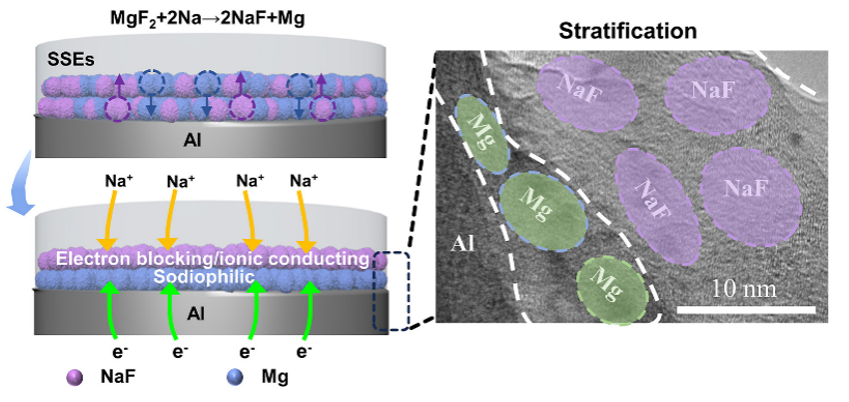
Charting new terrain in energy storage: the emergence of zero-sodium-excess solid-state batteries

Stratified Interphase Design for Stable Sodium Batteries. This illustration demonstrates the stratified interphase in zero-sodium-excess batteries, featuring a sodiophilic magnesium (Mg) bottom layer and a sodiophobic sodium fluoride (NaF) top layer.
FAYETTEVILLE, GA, UNITED STATES, March 31, 2025 /EINPresswire.com/ -- A cutting-edge breakthrough in zero-sodium-excess solid-state batteries may reshape the energy storage landscape. This innovative study introduces a novel interphase design to address the persistent challenges of low energy density and poor interfacial stability in sodium-ion batteries, offering a solution poised to revolutionize next-generation energy storage systems.
Sodium-ion batteries are celebrated for their cost-effectiveness and scalability, yet their progress has been stymied by inherent issues like limited energy density and instability. Zero-sodium-excess batteries (ZSBs) were conceptualized to overcome these drawbacks by removing excess sodium and optimizing efficient stripping and plating processes. However, unresolved hurdles, such as interfacial voids and thermodynamic instabilities between solid-state electrolytes and current collectors, have necessitated further exploration into advanced interphase designs.
In a pivotal study (DOI: 10.1016/j.esci.2024.100274) conducted by the College of Science & Institute for Sustainable Energy at Shanghai University, researchers unveiled a game-changing stratification approach, published in eScience on May 1, 2024. By exploiting differences in adsorption energy, they engineered a dual-layer interphase comprising a sodiophilic magnesium (Mg) layer beneath a thermodynamically stable sodium fluoride (NaF) layer. This dual-layer configuration effectively suppresses dendrite formation and enhances battery stability, marking a major milestone for practical applications.
The heart of this innovation lies in its unique interphase structure. The sodiophilic Mg layer improves sodium nucleation, ensuring uniform deposition, while the sodiophobic NaF layer acts as an ionic conductor and electron insulator, mitigating side reactions and improving thermodynamic stability. Together, these features enable the ZSBs to deliver a remarkable energy density of 254.4 Wh/kg with an 82.7% capacity retention over 350 cycles, far surpassing conventional approaches. Additionally, the design minimizes plating overpotential and improves critical current density, showcasing exceptional electrochemical and mechanical performance. While the current fabrication relies on magnetron sputtering, scalable techniques like chemical vapor deposition could unlock its industrial potential, bridging the gap between research and commercialization.
Dr. Wuliang Feng, the lead researcher, emphasized the significance of this innovation, stating: “This stratification strategy offers a transformative approach to solid-state battery design. By addressing the fundamental challenges of interfacial instability, we have created a pathway for developing high-performance batteries that meet the demands of next-generation energy storage systems.”
The implications of this research are profound, extending to applications in renewable energy grids, electric vehicles, and beyond. By enhancing the viability of ZSBs for large-scale energy storage, this breakthrough could accelerate the transition to sustainable energy solutions. Furthermore, the proposed scalable manufacturing techniques pave the way for widespread adoption, turning this innovative concept into a practical, commercially viable technology.
References
DOI
10.1016/j.esci.2024.100274
Original Source URL
https://doi.org/10.1016/j.esci.2024.100274
Funding Information
This work is supported by National Natural Science Youth Foundation of China (Grant Nos. 22209104), National Natural Science Foundation of China (Grant Nos.22179077), Shanghai Science and Technology Commission's “2020 Science and Technology In-novation Action Plan” (20511104003), and Natural Science Foundation in Shanghai (21ZR1424200) and Shanghai Technical Service Center of Science and Engineering Computing, Shanghai University.
Lucy Wang
BioDesign Research
email us here
Distribution channels: Science, Technology
Legal Disclaimer:
EIN Presswire provides this news content "as is" without warranty of any kind. We do not accept any responsibility or liability for the accuracy, content, images, videos, licenses, completeness, legality, or reliability of the information contained in this article. If you have any complaints or copyright issues related to this article, kindly contact the author above.
Submit your press release